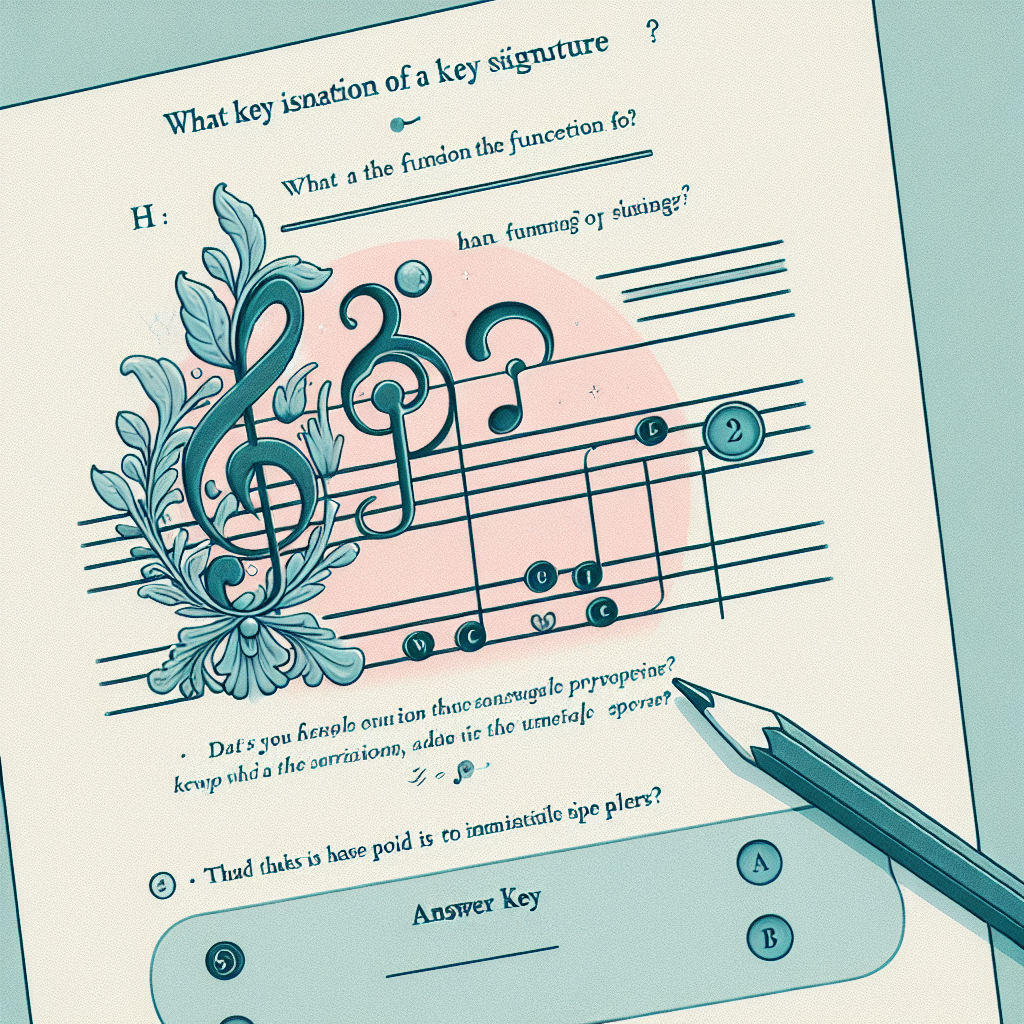Introduction
The function of a key signature is crucial in the realm of music theory, serving as an essential component that indicates the tonality of a piece of music. A key signature is a collection of sharps or flats placed at the beginning of a musical staff, determining which notes are to be raised or lowered throughout the piece. This not only helps musicians understand the scale used but also facilitates easier sight-reading by providing a visual cue for the specific key in which the composition is written. In essence, the key signature establishes the harmonic framework and influences the mood, color, and character of the music, guiding performers in playing with appropriate intentions. Understanding key signatures enhances one’s ability to read and interpret music effectively, making it a foundational element for musicians and composers alike.
The Role and Importance of Key Signatures
Key signatures play a pivotal role in the structure of Western music. Without them, music would be far more complex and difficult to read. Here’s a deeper exploration of their functions and significance:
1. Defining Tonality
A key signature identifies the tonality of a piece, indicating whether it is in a major or minor key. Major keys typically sound brighter and more uplifting, while minor keys evoke a darker, more somber tone. For instance, the key signature of C major has no sharps or flats, suggesting a straightforward, consonant sound, while A minor, its relative minor, also uses the same key signature but conveys a different emotional texture.
2. Streamlining Musical Notation
By using key signatures, composers can simplify the notation of music. Instead of writing out each sharp or flat note throughout a piece, the key signature allows musicians to know in advance which notes will be altered. This makes the sheet music cleaner and easier to read, especially for complex compositions. For instance, if a piece is in G major, the key signature will include one sharp (F#) and instruct musicians to consistently play this note as sharp during the entire composition.
3. Facilitating Communication Among Musicians
Key signatures act as a universal language among musicians, providing a clear framework for collaboration. When musicians read a piece of sheet music, they are immediately aware of the musical context, which assists in maintaining a cohesive performance. This allows for effective ensemble playing, as all musicians interpret the key signature in the same way.
4. Influencing Musical Structure and Composition
The choice of key can shape the compositional process itself. Composers often gravitate towards specific keys when striving to evoke certain emotions. For example, pieces in D major are frequently associated with triumph and joy, while those in E minor may express melancholy. Furthermore, modulation to different keys during a piece can create contrast and emotional shifts, enhancing the listener’s experience.
5. Enhancing Sight-Reading Skills
For musicians, understanding key signatures is essential for developing strong sight-reading skills. Familiarity with key signatures assists in quickly identifying relevant sharps or flats, thereby allowing musicians to read music with greater fluency and confidence. Practicing scales in various keys can further reinforce this skill.
Types of Key Signatures
Key signatures fall into two primary categories: major and minor, each having a unique set of sharps or flats. Here’s a breakdown:
Major Key Signatures
| Key | Sharps |
|---|---|
| C Major | No sharps or flats |
| G Major | 1 sharp (F#) |
| D Major | 2 sharps (F#, C#) |
| A Major | 3 sharps (F#, C#, G#) |
| E Major | 4 sharps (F#, C#, G#, D#) |
| B Major | 5 sharps (F#, C#, G#, D#, A#) |
| F# Major | 6 sharps (F#, C#, G#, D#, A#, E#) |
| C# Major | 7 sharps (F#, C#, G#, D#, A#, E#, B#) |
Minor Key Signatures
| Key | Sharps |
|---|---|
| A Minor | No sharps or flats |
| E Minor | 1 sharp (F#) |
| B Minor | 2 sharps (F#, C#) |
| F# Minor | 3 sharps (F#, C#, A#) |
| C# Minor | 4 sharps (F#, C#, G#, D#) |
| G# Minor | 5 sharps (F#, C#, G#, D#, A#) |
| D# Minor | 6 sharps (F#, C#, G#, D#, A#, E#) |
| A# Minor | 7 sharps (F#, C#, G#, D#, A#, E#, B#) |
Flat Key Signatures
| Key | Flats |
|---|---|
| C Major | No sharps or flats |
| F Major | 1 flat (B♭) |
| B♭ Major | 2 flats (B♭, E♭) |
| E♭ Major | 3 flats (B♭, E♭, A♭) |
| A♭ Major | 4 flats (B♭, E♭, A♭, D♭) |
| D♭ Major | 5 flats (B♭, E♭, A♭, D♭, G♭) |
| G♭ Major | 6 flats (B♭, E♭, A♭, D♭, G♭, C♭) |
| C♭ Major | 7 flats (B♭, E♭, A♭, D♭, G♭, C♭, F♭) |
Understanding the Circle of Fifths
The Circle of Fifths is an invaluable tool for understanding key signatures. It visually represents the relationships between different keys, showing how many sharps or flats each key signature contains. In the protection of compositional structure, the Circle can aid in modulation and transitioning smoothly between different keys. Its arrangement demonstrates that moving clockwise adds sharps, while moving counterclockwise adds flats. Musicians can utilize it for crafting pieces that explore various tonalities, thereby enriching their compositions.
Practical Applications of Key Signatures
For Composers
Composers leverage key signatures to create emotional landscapes and define the character of their music. By selecting the appropriate key, they can establish desired feelings, whether it’s joy, sadness, tension, or resolution. A nuanced understanding of key signatures can help composers experiment with modulation, thus diversifying their harmonic palette.
For Performers
Performers benefit from knowing key signatures as this knowledge aids in interpreting pieces. Recognizing the emotional context that different keys convey can guide performers in expressing the music more authentically. Additionally, familiarity with key signatures enhances sight-reading abilities, allowing for quicker adaptation to new pieces.
Common Misconceptions about Key Signatures
Despite their importance, some misconceptions persist regarding key signatures. One commonly held belief is that key signatures solely relate to sharp and flat notes; however, they also inform the overall mood and structure of a piece. Another misconception is that key signatures can always be simplified to a single major or minor indication. In reality, many pieces exhibit complex modulations and may shift between multiple keys, requiring performers to adapt accordingly.
FAQs
What is a key signature in music?
A key signature is a set of sharps or flats placed at the beginning of a staff to indicate the notes that are altered throughout a piece of music, establishing its tonality.
Why are key signatures important?
Key signatures are important because they streamline musical notation, define tonality, enhance sight-reading skills, and aid in collaboration among musicians.
How do I learn key signatures?
Learning key signatures can be facilitated through practice exercises such as identifying them in sheet music, using flashcards, and studying the Circle of Fifths.
Can a piece of music change key signatures?
Yes, pieces can modulate to different key signatures throughout their progression, enhancing the emotional impact and complexity of the music.
What are the key signature rules for sharps and flats?
For sharps, the last sharp in the key signature indicates the seventh scale degree. For flats, the second-to-last flat indicates the key. Understanding these rules can assist musicians in quickly identifying keys.



